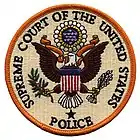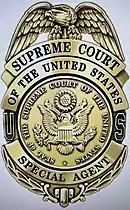Supreme Court Police
The Supreme Court of the United States Police is a federal law enforcement agency that derives its authority from 40 U.S.C. § 6121. The Supreme Court Police enforces federal and District of Columbia laws and regulations, as well as enforces regulations governing the Supreme Court Building and grounds prescribed by the marshal and approved by the Chief Justice of the United States. The department's mission is to ensure the integrity of the constitutional mission of the Supreme Court of the United States by protecting the Supreme Court, the justices, employees, guests, and visitors.
| Supreme Court of the United States Police | |
|---|---|
 Patch of the US Supreme Court Police | |
 Logo of the US Supreme Court | |
 Badge of a US Supreme Court Police Officer | |
| Agency overview | |
| Formed | 1935 |
| Employees | 189 |
| Jurisdictional structure | |
| Federal agency | U.S. |
| Operations jurisdiction | U.S. |
| Governing body | Marshal of the United States Supreme Court |
| General nature | |
| Operational structure | |
| Headquarters | Washington, D.C. |
| Sworn members | 189 |
| Website | |
| https://www.scuspd.gov/ | |

.jpg.webp)
History
Established in 1935, the Supreme Court security force was tasked to provide protection for the new Supreme Court building. The Court had previously resided in the United States Capitol, and the original force of 33 officers were selected from the ranks of the United States Capitol Police. As of 2023, the Supreme Court Police has an authorized force of 189 officers.
Duties
The Supreme Court Police are responsible for providing a full range of police services, including:
- Protection of the Supreme Court Building and grounds, and persons and property therein;
- Dignitary Protection for the Supreme Court Justices, both domestically and Internationally;
- Maintain suitable order and decorum within the Supreme Court Building and grounds, to include policing demonstrations and large-scale events;
- Provide Courtroom security;
- Prepare numerous reports to include incident, found property, accident, and arrest reports, as well as testify in court.
Special Units are available to officers depending on time-in-service, completion of training, and experience.
Units
.jpg.webp)
The Supreme Court Police offers both part-time and full-time specialized units. These units include:
- Dignitary Protection Unit
- Protective Intelligence Unit
- K-9 Unit
- Background Investigations Unit
- Nuclear, Biological, Chemical (NBC) Team
- Recruitment Division
- Police Operations Center - Dispatch
- Physical Security Unit
- Liaison positions with partner agencies (FBI, JTTF, DHS, USCP)
- Civil Disturbance Unit
- Training Unit
- Radio Technicians
- Honor Guard
- Various instructor positions, including: Firearms, Driving, Defensive Tactics, CPR/First Aid, Fitness Coordinators.[1]
Training
.jpg.webp)
Supreme Court Police Officers attend the 13 week Uniformed Police Training Program (UPTP) at the Federal Law Enforcement Training Center (FLETC) in Georgia. Designated members of specialized units attend the Criminal Investigator Training Program (CITP) at FLETC. Working for the Supreme Court of the United States Police offers a comprehensive benefits package that includes, in part, paid vacation, sick leave, holidays, life insurance, health insurance benefits, premium pay, and eligibility for retirement with 20 years of service at age 50, or 25 years’ service at any age. Requirements and qualifications for the position are listed on the Supreme Court's website and on USAjobs. Applications are accepted via USAjobs.
Salary
In 2023, the starting salary for a newly hired member of the Supreme Court Police is $77,441 a year.[2]
The Supreme Court Police also accept lateral hires from Local, State and Federal agencies. The starting salary for a lateral hire is $77,441–$132,391.